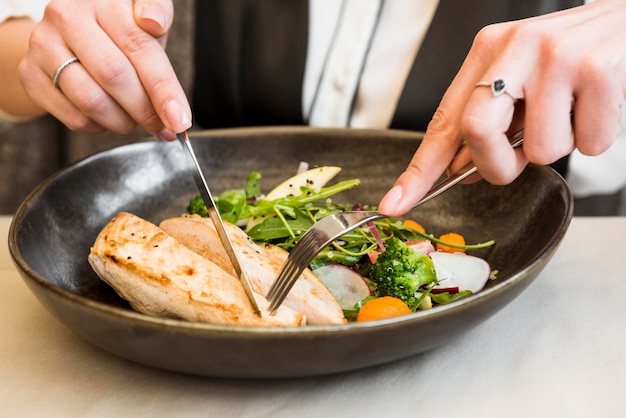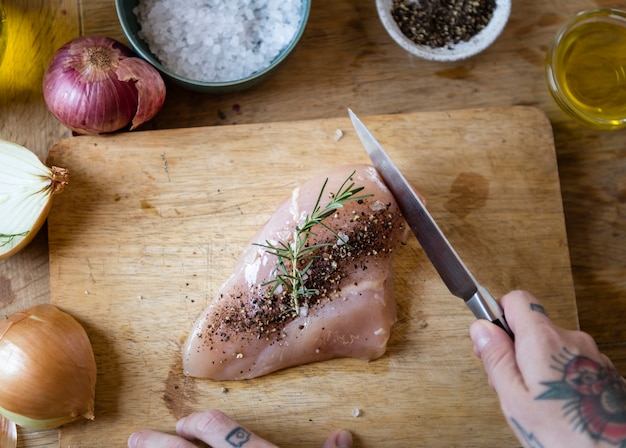Let's be honest, swordfish is a bit of a culinary hero. It's got that firm texture, that bold flavor, and a certain "wow" factor that makes it stand out from the crowd. But like any great hero, it needs to be treated right to reach its full potential.
So, grab your apron, fellow foodies, because we're diving deep into the world of swordfish steaks. We'll uncover the secrets to choosing the best cuts, mastering the perfect sear, and unlocking those flavor bombs that will have you saying, "This is the best swordfish I've ever had!"
(Part 1) The Swordfish: A Closer Look

choosing the right cut
First things first, let's talk about the cuts. Swordfish is usually sold in either steaks or fillets, and they're like two different chapters in the same delicious story.
Steaks: Imagine thick, juicy slices, usually cut from the loin or belly. These are the champions of grilling, pan-searing, and baking. They tend to have a richer, more intense flavor than fillets.
Fillets: Picture long, thin slices, usually cut from the sides of the fish. They're more delicate and cook up quickly.
Personally, I'm a steak guy. They just seem to have that "oomph" that I love. But hey, culinary journeys are all about personal preference!
Understanding Swordfish Quality
You've got your cut chosen, but now you need to be a swordfish detective. Here's what to look for when you're shopping:
Firm Texture: A good swordfish steak should feel firm to the touch, like a well-toned muscle. If it feels mushy or soft, it's likely not at its prime.
Bright Color: The flesh should have a vibrant, slightly iridescent pink-red color. Think of it like a healthy blush. If it's faded or dull, it might be on the older side.
No Strong Odor: Fresh swordfish has a mild, pleasant aroma. If it has a strong, fishy smell, it's probably best to move on.
Storing Swordfish
Once you've scored your perfect swordfish, it's time to treat it like royalty. Wrap it tightly in plastic wrap or store it in an airtight container. Keep it in the refrigerator for up to two days. You can also freeze it for up to three months, but remember, the texture might change a bit.
(Part 2) Getting Ready to Cook

Thawing Swordfish
If you've got frozen swordfish, you need to bring it back to life. The best way is to thaw it slowly and evenly in the refrigerator overnight. This helps preserve its moisture and ensures a delicious result.
You can also thaw it in cold water, but make sure to change the water every 30 minutes to prevent bacterial growth.
Patting it Dry
Once your swordfish is thawed, grab some paper towels and give it a gentle pat down. This helps remove excess moisture, preventing it from steaming instead of searing and achieving that crispy crust we all crave.
(Part 3) cooking techniques

Pan-Seared Swordfish
Now, let's get down to business! Pan-searing is my go-to method for swordfish. It creates a beautiful, crispy crust while keeping the inside tender and juicy. It's like giving your taste buds a symphony of textures.
The Essentials for Pan-Searing:
Cast Iron or stainless steel pan: A sturdy pan that can handle high heat.
High Heat: We want that pan blazing hot!
A Little Bit of Oil: Just enough to coat the bottom of the pan.
Salt and Pepper: The foundation of flavor.
Step-by-Step Guide:
1. Heat the Pan: Get your pan roaring hot, then add a tablespoon of oil. You want the oil shimmering.
2. Season the Fish: Generously season your swordfish steaks with salt and pepper.
3. Sear the Swordfish: Carefully place the swordfish steaks into the hot pan. Let them sear for 3-4 minutes per side, or until they're golden brown and cooked through. The goal is that perfect, crispy crust.
4. Rest the Fish: Take the swordfish out of the pan and let it rest for 5 minutes before serving. This allows the juices to redistribute, making for a more succulent bite.
Grilling Swordfish
For those who love a smoky flavor, grilling is the way to go. It's a simple technique that yields incredible results.
The Essentials for Grilling:
Gas or charcoal grill: Pick your weapon of choice.
High Heat: We want those grates scorching!
A Grill Brush: To ensure a clean surface for your swordfish.
Salt and Pepper: Our trusty flavor buddies.
Step-by-Step Guide:
1. Prepare the Grill: Preheat your grill to medium-high heat. Clean those grates with your grill brush to ensure a perfect sear.
2. Season the Fish: Season those swordfish steaks generously with salt and pepper.
3. Grill the Swordfish: Place the steaks on the hot grill. Cook for 3-4 minutes per side, or until they are cooked through and have those beautiful grill marks.
4. Rest the Fish: Remove the swordfish from the grill and let it rest for 5 minutes before serving.
Baking Swordfish
Baking is a great way to cook swordfish if you're looking for a healthy and hands-off approach. It's perfect for a large batch and lets you focus on other things while your dinner cooks.
The Essentials for Baking:
Baking Sheet: Your trusty oven companion.
Parchment Paper: To prevent sticking and make cleanup a breeze.
Olive Oil: For a touch of flavor and moisture.
Salt and Pepper: The flavor duo we can't live without.
Step-by-Step Guide:
1. Preheat Oven: Fire up your oven to 400°F (200°C).
2. Prepare the Pan: Line your baking sheet with parchment paper.
3. Season the Fish: Season the swordfish steaks with salt and pepper, and drizzle them with olive oil.
4. Bake the Fish: Place the swordfish steaks on the prepared baking sheet and bake for 10-12 minutes, or until they are cooked through.
5. Rest the Fish: Remove the swordfish from the oven and let it rest for 5 minutes before serving.
(Part 4) cooking time
Checking for Doneness
The key to perfect swordfish is knowing when it's cooked through but not overcooked. It's about finding that sweet spot of tenderness and flavor.
internal temperature: The most reliable way to check for doneness is to use a meat thermometer. Swordfish is cooked through when it reaches an internal temperature of 145°F (63°C).
The "Flake Test": You can also check by inserting a fork into the thickest part of the steak. If the fish flakes easily, it's cooked through.
Overcooking Swordfish
Overcooked swordfish becomes dry, tough, and frankly, a little sad. Remember, a little bit undercooked is better than overcooked. So, err on the side of caution.
(Part 5) Swordfish Marinades and Seasonings
Marinate for Added Flavour
Now, let's get creative! Marinades are like a secret weapon for boosting swordfish flavor.
Some Popular Marinade Ideas:
Citrus Marinade: Combine lemon juice, olive oil, garlic, and fresh herbs like thyme or rosemary. It's a burst of freshness.
Soy Marinade: Mix soy sauce, honey, ginger, and garlic. It's a beautiful blend of sweet and savory.
Mediterranean Marinade: Combine olive oil, red wine vinegar, oregano, garlic, and black pepper. It's a taste of the sun-drenched Mediterranean.
Marinating Time:
Marinades can work their magic in as little as 30 minutes, but they can also hang out with your swordfish for several hours. Just make sure to keep it refrigerated during the process.
Seasonings
Let's talk seasonings! You can use a variety of spices and herbs to enhance the flavor of swordfish.
Popular Seasoning Ideas:
Lemon Pepper: A classic combination that adds a bright, tangy flavor.
Paprika: A sweet and smoky spice that adds depth and warmth.
Chili Powder: For those who like a little heat, chili powder adds a fiery kick.
Garlic Powder: A must-have for any seafood lover.
Herbs: Fresh or dried herbs, like parsley, dill, or cilantro, can really brighten up swordfish.
(Part 6) Serving Swordfish
side dishes
Now that you've got your perfectly cooked swordfish, it's time to find the perfect companions.
Classic Side Dish Combinations:
grilled vegetables: Grilled bell peppers, zucchini, and onions are a classic combination that pairs beautifully with the rich flavor of swordfish.
Roasted Potatoes: Roasted potatoes with herbs and garlic add a satisfying touch to your meal.
rice pilaf: A flavorful and versatile side dish that complements swordfish perfectly.
Salad: A light and refreshing salad with a vinaigrette dressing adds a nice contrast to the richness of the swordfish.
Sauces
A sauce can really elevate your swordfish to the next level.
Popular Sauce Ideas:
Lemon Butter Sauce: A simple and classic sauce that adds a bright and tangy flavor.
Garlic Herb Sauce: A flavorful sauce made with garlic, herbs, and butter.
Tomato Sauce: A rich and flavorful sauce made with tomatoes, onions, and garlic.
Wine Pairings
If you're enjoying your swordfish with a glass of wine, here are some suggestions:
Wine Pairing Ideas:
White Wine: A crisp Sauvignon Blanc or Pinot Grigio would pair well with the delicate flavor of swordfish.
Red Wine: A lighter red wine, like a Pinot Noir or a Gamay, would also complement the flavor of swordfish.
(Part 7) Recipes
grilled swordfish with Lemon-Herb Marinade
This recipe is a classic for a reason. It's simple, delicious, and perfect for a weeknight meal. The lemon-herb marinade is bright and refreshing, making it a true crowd-pleaser.
Ingredients:
1 lb swordfish steaks
1/4 cup olive oil
2 tablespoons lemon juice
1 tablespoon chopped fresh parsley
1 tablespoon chopped fresh dill
1 clove garlic, minced
1/2 teaspoon salt
1/4 teaspoon black pepper
Instructions:
1. In a shallow dish, combine the olive oil, lemon juice, parsley, dill, garlic, salt, and pepper.
2. Add the swordfish steaks to the marinade and turn to coat.
3. Cover the dish and refrigerate for at least 30 minutes, or up to 2 hours.
4. Preheat your grill to medium-high heat.
5. Remove the swordfish steaks from the marinade and discard the marinade.
6. Grill the swordfish steaks for 3-4 minutes per side, or until they are cooked through.
7. Serve immediately.
Pan-Seared Swordfish with Garlic Herb Butter
This recipe is perfect for a special occasion. The pan-seared swordfish is tender and juicy, and the garlic herb butter is flavourful and aromatic. It's a dish that's sure to impress.
Ingredients:
1 lb swordfish steaks
1 tablespoon olive oil
1/2 teaspoon salt
1/4 teaspoon black pepper
2 tablespoons butter
2 cloves garlic, minced
1 tablespoon chopped fresh parsley
1/4 teaspoon lemon juice
Instructions:
1. Season the swordfish steaks with salt and pepper.
2. Heat the olive oil in a large skillet over medium-high heat.
3. Add the swordfish steaks to the skillet and cook for 3-4 minutes per side, or until they are cooked through.
4. Remove the swordfish steaks from the skillet and set aside.
5. In the same skillet, melt the butter over medium heat.
6. Add the garlic and cook for 1 minute, or until fragrant.
7. Stir in the parsley and lemon juice.
8. Pour the garlic herb butter over the swordfish steaks and serve immediately.
baked swordfish with Mediterranean Vegetables
This recipe is a healthy and flavorful option for a weeknight meal. The baked swordfish is tender and juicy, and the Mediterranean vegetables are flavorful and aromatic. It's a delicious and easy way to bring a taste of the Mediterranean to your kitchen.
Ingredients:
1 lb swordfish steaks
1 tablespoon olive oil
1/2 teaspoon salt
1/4 teaspoon black pepper
1 cup cherry tomatoes
1 cup zucchini, diced
1/2 cup red onion, diced
2 cloves garlic, minced
1/4 cup chopped fresh oregano
1/4 cup red wine vinegar
Instructions:
1. Preheat oven to 400°F (200°C).
2. Line a baking sheet with parchment paper.
3. In a large bowl, combine the cherry tomatoes, zucchini, red onion, garlic, oregano, red wine vinegar, salt, and pepper.
4. Toss to coat.
5. Place the swordfish steaks on the prepared baking sheet.
6. Pour the Mediterranean vegetables over the swordfish steaks.
7. Bake for 15-20 minutes, or until the swordfish is cooked through and the vegetables are tender.
8. Serve immediately.
(Part 8) FAQs
1. Is swordfish good for you?
Yes, swordfish is a good source of protein, omega-3 fatty acids, and other essential nutrients. However, it's also high in mercury, so it's best to eat it in moderation, especially for pregnant women and young children.
2. How long does it take to cook swordfish?
The cooking time for swordfish will vary depending on the thickness of the steaks and the cooking method you choose. In general, swordfish steaks will take 3-4 minutes per side on the grill or in the pan, and 10-12 minutes in the oven.
3. What's the best way to store swordfish?
Store swordfish in the refrigerator for up to two days, wrapped tightly in plastic wrap or in an airtight container. You can also freeze swordfish for up to three months.
4. What can I do with leftover swordfish?
Leftover swordfish can be used in a variety of dishes, such as salads, sandwiches, or pasta dishes. You can also flake it and use it in a fish chowder or a fish pie.
5. How do I know if swordfish is bad?
If swordfish has a strong, fishy odor, it's probably not fresh. You should also avoid eating swordfish that has a mushy texture or a dull, faded color.
(Part 9) Conclusion
So there you have it, folks! Your ultimate guide to cooking perfect swordfish steaks. Now, go forth and cook some incredible swordfish! You've got this!
Everyone is watching

Perfect Rice Every Time: The Ultimate Guide to Cooking Rice
Cooking TipsAs a self-proclaimed foodie, I've always been a bit obsessed with rice. It's the foundation of countless cuisi...

Ultimate Guide to Cooking the Perfect Thanksgiving Turkey
Cooking TipsThanksgiving. Just the word conjures up images of overflowing tables laden with delicious food, the scent of r...

The Ultimate Guide to Cooking Asparagus: Tips, Techniques, and Recipes
Cooking TipsAsparagus. The mere mention of this spring delicacy conjures up images of vibrant green spears, crisp and burs...

Can You Cook Spaghetti with Gasoline? (The Shocking Truth)
Cooking TipsWe've all seen those crazy internet trends. You know, the ones that make you wonder, "Did someone actually try...

Chorizo and Eggs Recipe: The Ultimate Guide
Cooking TipsRight, let’s talk about chorizo and eggs. You know, that classic Spanish dish that's always a winner. It's th...
